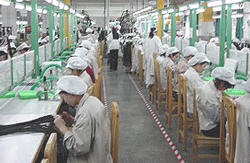Even though the injection molding industry uses a lot of expensive capital equipment, labor costs are still the largest single component of production costs. China’s main cost advantage in mold making comes from savings in this area. Chinese wages for toolmakers are among the lowest in the world; whereas in the US a tool maker easily earns over $40,000 per year, a Chinese tool maker will happily do the same job for US$ 1,000.
The Chinese labor force is also well educated, thus keeping training costs low, and Chinese factories do not have the high healthcare and insurance costs of the US and Europe.
Chinese factories reverse this process, however, by taking capital out of the production process and reintroducing a greater role for labor. Parts are designed to be made, handled, and assembled manually. This reduces the total capital required by as much as one-third. So while output per worker may be lower in Chinese factories, the combination of lower wages and less capital typically raises the return on capital above U.S. factory levels.
Factory overhead costs for many Western injection mold manufacturers are high compared with certain foreign competitors. This is partly the result of firms operating at less than full capacity because of weak business conditions and intense foreign competition. Many Chinese firms operate 24 hours a day, 7 days a week, thus more fully utilizing their expensive machinery and making it relatively less costly (subject to adjustments for power saving schedules).
A central benefit of Chinese tooling is that it allows the customer to make a profit using high-quality injection molding techniques at lower volumes than would often be required in the West. For example, customers using vacuum formings can often save a great deal of money by switching to China-based injection molding.
When tools are imported to the West, tariffs sometimes apply, but many injection tools and stamping dies are tariff-free. When tariffs do apply, on dies they often range from 2.9% to 5.7% and on molds from zero to 3.8%. EU tariffs are also low (ranging from zero to 5%)
